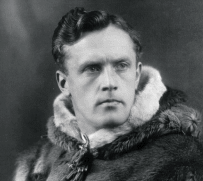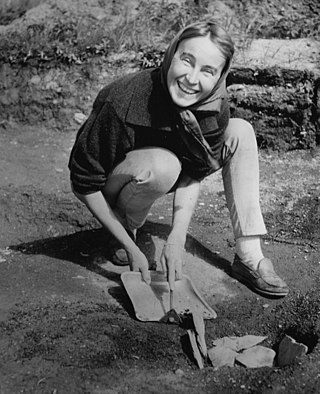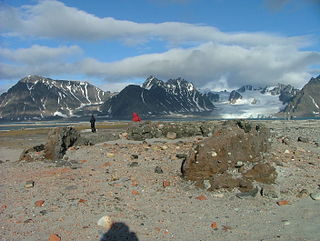Related Research Articles

Aphrodisias was a small ancient Greek Hellenistic city in the historic Caria cultural region of western Anatolia, Turkey. It is located near the modern village of Geyre, about 100 km (62 mi) east/inland from the coast of the Aegean Sea, and 230 km (140 mi) southeast of İzmir.

Helge Marcus Ingstad was a Norwegian explorer. In 1960, after mapping some Norse settlements, Ingstad and his wife archaeologist Anne Stine Ingstad found remnants of a Viking settlement in L'Anse aux Meadows in the province of Newfoundland in Canada. They were thus the first to prove conclusively that the Icelandic/Greenlandic Norsemen such as Leif Erickson had found a way across the Atlantic Ocean to North America, roughly 500 years before Christopher Columbus and John Cabot. He also thought that the mysterious disappearance of the Greenland Norse Settlements in the 14th and 15th centuries could be explained by their emigration to North America.

Constans II, nicknamed "the Bearded", was the Byzantine emperor from 641 to 668. Constans was the last attested emperor to serve as consul, in 642, although the office continued to exist until the reign of Leo VI the Wise. His religious policy saw him steering a middle line in disputes between the Orthodoxy and Monothelitism by refusing to persecute either and prohibited discussion of the natures of Jesus Christ under the Type of Constans in 648. His reign coincided with Muslim invasions under Mu'awiya I in the late 640s to 650s. Constans was the first emperor to visit Rome since the fall of the Western Roman Empire in 476, and the last one to visit Rome while it was still held by the Empire.
Archaeology is the study of human activity in the past, primarily through the recovery and analysis of the material culture and environmental data that they have left behind, which includes artifacts, architecture, biofacts and cultural landscapes.

Anne Stine Ingstad was a Norwegian archaeologist who, along with her husband explorer Helge Ingstad, discovered the remains of a Norse settlement at L'Anse aux Meadows in the Canadian province of Newfoundland and Labrador in 1960.
The year 1968 in archaeology involved some significant events.
The year 1997 in archaeology involved some significant events.
The year 1961 in archaeology involved some significant events.
Below are notable events in archaeology that occurred in 1906.

The Vinland Sagas are two Icelandic texts written independently of each other in the early 13th century—The Saga of the Greenlanders and The Saga of Erik the Red. The sagas were written down between 1220 and 1280 and describe events occurring around 970–1030.
Cyril Alexander Mango was a British scholar of the history, art, and architecture of the Byzantine Empire. He is celebrated as one of the leading Byzantinists of the 20th century.

Aztec architecture is a late form of Mesoamerican architecture developed by the Aztec civilization. Much of what is known about this style of architecture comes from the structures that are still standing. These structures have survived for several centuries because of the strong materials used and the skill of the builders. Most civic architecture was concentrated in the center of Aztec cities. However, many cities had smaller supplemental ceremonial areas.

The Coatlicue statue is one of the most famous surviving Aztec sculptures. It is a 2.52 metre (8.3 ft) tall andesite statue by an unidentified Mexica artist. Although there are many debates about what or who the statue represents, it is usually identified as the Aztec deity Coatlicue ("Snakes-Her-Skirt"). It is currently located in the National Museum of Anthropology in Mexico City. Originally displayed in the Mexica city of Tenochtitlan, the momentous statue was buried after the 1521 Spanish conquest of the city and excavated roughly 270 years later in 1790.

Byzantine studies is an interdisciplinary branch of the humanities that addresses the history, culture, demography, dress, religion/theology, art, literature/epigraphy, music, science, economy, coinage and politics of the Eastern Roman Empire. The discipline's founder in Germany is considered to be the philologist Hieronymus Wolf (1516–1580), a Renaissance Humanist. He gave the name "Byzantine" to the Eastern Roman Empire that continued after the Western Roman Empire collapsed in 476 AD. About 100 years after the final conquest of Constantinople by the Ottomans, Wolf began to collect, edit, and translate the writings of Byzantine philosophers. Other 16th-century humanists introduced Byzantine studies to Holland and Italy. The subject may also be called Byzantinology or Byzantology, although these terms are usually found in English translations of original non-English sources. A scholar of Byzantine studies is called a Byzantinist.

Dibsi Faraj is an archaeological site on the right bank of the Euphrates in Aleppo Governorate (Syria). The site was excavated as part of a larger international effort coordinated by UNESCO to excavate as many archaeological sites as possible in the area that would be flooded by the reservoir created by the Tabqa Dam, which was being built at that time. An initial, small archaeological sounding was done at Dibsi Faraj by the Syrian Department of Antiquities in 1971. Following this investigation, the site was excavated between 1972 and 1974 as part of a joint operation of the Dumbarton Oaks Center for Byzantine Studies and the Kelsey Museum of Archaeology at the University of Michigan under the direction of Richard P. Harper. Since then, the site has disappeared under the rising waters of Lake Assad, the reservoir created by the Tabqa Dam.

The archaeology of Svalbard is the study of human activity in the northerly Arctic Ocean archipelago's past. The geography, environment and climate of Svalbard have resulted in exceptional preservation conditions. Archaeological fieldwork on Svalbard is both expensive and physically exhausting, but new technology and infrastructure has allowed easier access. This easier access has also resulted in more damage caused by tourists.
References
- ↑ Radford, David (2018). The Archaeology of Oxford in 20 digs. Stroud: Amberley Publishing. pp. 12–15. ISBN 978-1-4456-8085-9.
- ↑ Kelly, John (13 January 2014). "Local Intriguing story behind a stone figure at Dumbarton Oaks". The Washington Post . Retrieved 12 August 2015.
- ↑ "Helge Marcus Ingstad". Encyclopedia Britannica. Retrieved 8 February 2019.